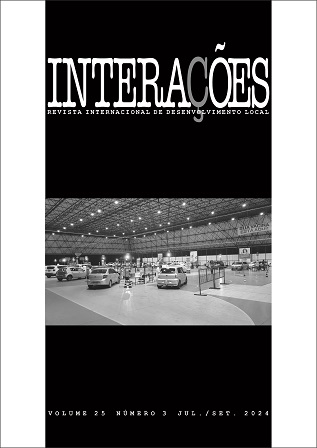Motivations to migrate: social networks and the decision-making process of contemporary migrant
Keywords:
migration, historical-structural model, social mediaAbstract
In this article, we aim to understand the motivations that stimulate contemporary migrations, as well as to know the relevance of social networks in the migrant's decision-making process. For this, we take as a starting point the historical-structural model, through which the various factors that influence decision-making on migration are visualized, making it an analysis of a social context suggested by capital, rather than a decision unique to each individual. Still, we seek to analyze the influence of social networks in the migratory process, through interviews with northeastern migrants who currently work in poultry processing plants in the cities of Forquilhinha and Nova Veneza (cities from the south of the state of Santa Catarina, where the two largest slaughterhouses in the region, which belong to JBS, are located). It was possible to conclude that, for the migrants in this article, the existence of a support network at the destination is preponderant for their choice, whether in the decision to migrate, but mainly, in choosing where to go. Additionally, it was understood that, more than an individual decision from the migrant, it is in the social and mainly economic context that the determination to migrate resides. Another question that was evidenced in the article was that migrants are moving to small cities, where there are more job opportunities.
References
ARAÚJO, Herton Heller; BOTELHO, Rosana Ulhoa; CODES, Ana Luiza Machado; SERRANO, Agnes de França; PINTO, Larissa de Morais. A migração interna dos jovens como alternativa para melhorar sua inserção no mundo do trabalho – evidências a partir dos censos de 2000-2010. In: ENCONTRO NACIONAL DE ESTUDOS POPULACIONAIS [ABEP], 19., 24 a 28 de novembro de 2014, São Pedro, SP. São Paulo: ABEP, 2014. Disponível em: http://www.abep.org.br/~abeporgb/abep.info /files/trabalhos /trabalho_completo/TC-1-5-151-229.pdf. Acesso em: 17 fev. 2023.
CAMPOS, Marden Barbosa. A dimensão espacial das redes migratórias. Redes, Santa Cruz do Sul, v. 20, n. 3, p. 14–30, set./dez. 2015.
CASTRO, Fatima Velez. A influência das redes sociais na estruturação geográfica do projecto migratório. Lisboa: Imprensa da Universidade de Lisboa, 2016. (Redes, capital humano e geografias da competitividade). Disponível em: https://digitalis-dsp.uc.pt/bitstream/10316.2/39067/1/A%20influencia%20das%20redes%20sociais.pdf Acesso em: 18 fev. 2023.
DUHRAN, Eunice R. A caminho da cidade. São Paulo: Perspectiva, 1973.
GOMES, Nayhara Freitas Martins. Municípios de pequeno porte do sudeste brasileiro: dinâmica migratória e aspectos econômicos. 2019. Tese (Doutorado em Geografia) – Universidade Federal de Minas Gerais, Belo Horizonte, 2019.
HARVEY, David. Espaços de esperança. 7. ed. São Paulo: Loyola, 2010.
LEE, Everett S. A theory of migration. Demography, [s.l.], v. 3, n. 1, p. 47–57, 1966.
OBSERVATÓRIO DAS MIGRAÇÕES INTERNACIONAIS [OBMIGRA]. O observatório. Portal de Imigração Laboral, [s.l.]. 25 mar. 2019. Disponível em: https://portaldeimigracao.mj.gov.br/pt/observatorio. Acesso em: 16 fev. 2023.
PORTELLI, Alessandro. O que faz a história oral diferente. Projeto História, São Paulo, v. 14, fev. 1997.
SANTOS, Milton. A urbanização brasileira. 5. ed. São Paulo: EDUSP, 2013.
SINGER, Paul. Globalização e desemprego: diagnóstico e alternativas. 8. ed. São Paulo: Contexto, 1998.
THOMSON, Alistair. História (co)movedoras: história oral e estudos de migração. Revista Brasileira de História, São Paulo, v. 22, n. 44, p. 341–64, 2002.
TRIBUNAL SUPERIOR ELEITORAL [TSE]. Resultados das eleições de 2022. Portal do TSE, Brasília-DF, 2022. Disponível em: https://resultados.tse.jus.br/oficial/app/index.html#/eleicao/resultados. Acesso em: 30 out. 2024.
Downloads
Published
How to Cite
Issue
Section
License
Copyright (c) 2024 João Henrique Zanelatto, Gabriela Rech Salib, Dimas de Oliveira Estevam

This work is licensed under a Creative Commons Attribution 4.0 International License.
Direitos Autorais para artigos publicados nesta revista são do autor, com direitos de primeira publicação para a revista. Em virtude de aparecerem nesta revista de acesso público, os artigos são de uso gratuito, com atribuições próprias, em aplicações educacionais e não-comerciais.


